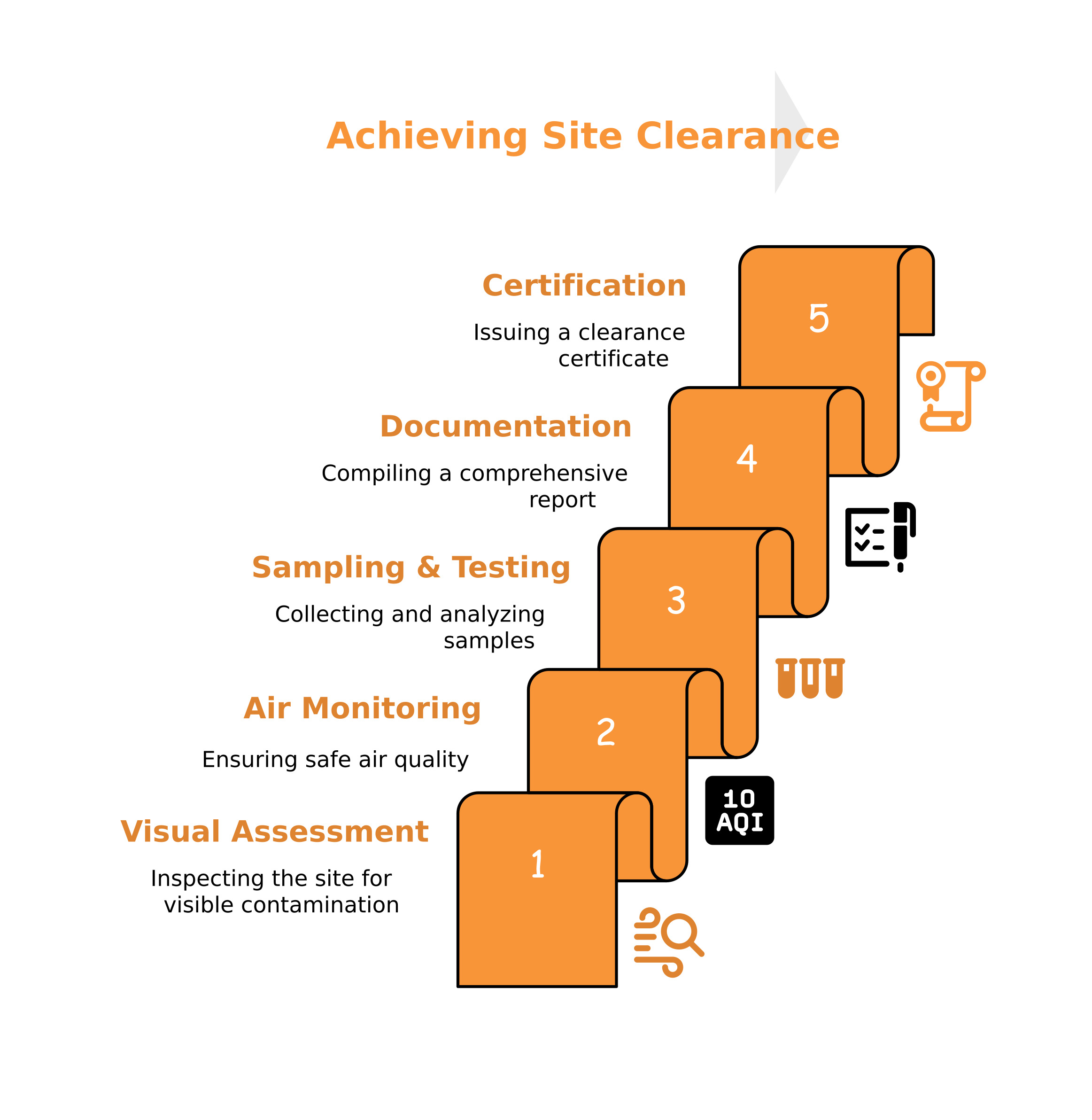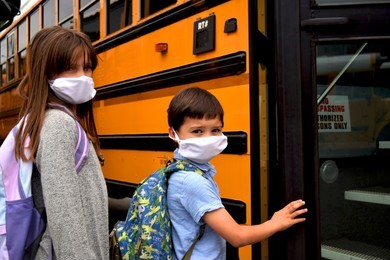After a project is completed and before the building is occupied, it is important to check if the space is safe for workers/residents/staff. This is doubly important post-mould remediation, asbestos removal, or hazardous material clean-up. This makes post-remediation verification and clearance inspections an important task.
In Australia, WHS and SafeWork regulations stipulate that every work site should be free and clear of any possible materials that may pose a threat to the health and safety of workers. Further, contaminants like mould, asbestos, and particulate matter can pose a threat to the health and safety of all occupants. To learn if any hazardous contaminants are present, it is important to inspect a site.
Let’s take a look at why clearance inspections and certificates are a necessity and a must for legal and safety compliance before re-occupying a property.
What Is a Clearance Inspection?
A clearance inspection is a final and official check that assesses whether or not an area is free of potentially hazardous materials, which may include lead, asbestos, mould, and others. Usually conducted by certified remediation experts, this process certifies if the project site is safe for occupancy on completion of the inspection.
The following key aspects make up a clearance inspection for a work site:
- Visual Inspection of the site.
- Air monitoring for particulate matter and airborne asbestos fibers.
- Dust testing to confirm the absence of possible hazardous contaminants.
- Post-remediation verification for compliance.
- Clearance certification issued by a qualified and competent authority.
Clearance inspections are conducted by licensed asbestos assessors and hygienists who hold the necessary certification to carry out these inspections. Further, the key compliance bodies involved in clearance inspections are
Safe Work Australia and state-based regulators.
Who Needs a Clearance Inspection in Australia?
The following people and organisations need clearance inspections from time to time:
Homeowners
Older properties (built or renovated before 1990) tend to contain asbestos, which needs to be evaluated during renovations, demolitions, buying, and/ or selling older properties.
Businesses
To ensure safe working premises for the staff, offices, warehouses, and industrial sites need to complete mould and asbestos clearance inspections.
Schools
Older schools may contain asbestos in the building material or have mould. Thus, it is mandatory to complete clearance inspections before reopening spaces to the staff and students.
Public Buildings
Public buildings not only have working staff, but also attract a large public footfall. Thus, to make the premises safe for the building staff as well as the general public, it is important to obtain all necessary environmental clearance certificates.
Construction and Demolition Sites
During and after a project that involves either construction or demolition, getting a clearance certification is mandatory. This needs to be completed before handing back control of a “cleared” site.
Landlords and Property Managers
To ensure tenant safety and legal compliance, landlords and property managers must obtain clearance for their properties, verifying that it is free of contaminants like mould and asbestos.
What are the Steps Involved in a Clearance Inspection?
Whether it is for asbestos, mould, or any other contaminant, clearance inspections involve the following steps:
Step 1: Visual Assessment
The site for which post-remediation verification and clearance inspections need to be checked for debris, dust, or visible contamination.
Step 2: Air Monitoring
This ensures that airborne pollutants, particulate matter, and fibres (especially asbestos) are within safe and permissible limits.
Step 3: Sampling and Lab Testing
If required, samples are taken from the site and sent to the lab to evaluate contamination levels and get a detailed report.
Step 4: Documentation and Evaluation
Based on the visual assessment, air monitoring reports, samples, and lab test results, a thorough report is compiled for the sites. This assesses their contaminant-free state and suitability for public occupation.
Step 5: Certification Issuance
If the site and (lab samples, if any) pass the checks and levels mandated, a Clearance Certificate is issued confirming that the site is safe to be occupied.

What Makes Clearance Inspections and Certifications Important
Completing clearance inspections for asbestos, mould, and other contaminants, and receiving the necessary certification offers the following:
Assurance of Safety
A clearance certificate issued by a competent authority that states that a site is safe for public occupancy serves as a safety assurance to people. It confirms that remediation work has been successfully conducted and the site is cleared of all hazardous materials.
Verifying Project Completion
Remediation work is taken up as one of the last steps of project completion, and needs to be completed before the project is commissioned and the space occupied. Receiving clearance certification is an important step in project completion, verifying that all work and remediation are complete.
Maintaining the Health of Workers and Occupants
By preventing exposure to asbestos fibres, hazardous dust, and harmful particulate matter, these inspections help ensure that occupants, residents, and workers do not suffer from ill-health.
Upholding Legal and Regulatory Compliance
Completing asbestos and mould clearance inspections is mandatory under WHS regulations in Australia. Further, these also help maintain compliance with the workplace and occupant safety laws for the different states.
Meeting Insurance and Liability Requirements
Renting or leasing a place that has possible mould or asbestos contamination can attract legal action. Thus, a post-remediation verification and clearance certificate can protect property owners and contractors from legal action.
Ensuring Peace of Mind
Post-remediation verification establishes that there are no hazards and contaminants present once necessary remediation work has been completed. Before a property or site is set up for reoccupation, completing this and obtaining a clearance certificate provides the peace of mind that an area is safe to be occupied.
What Happens If a Thorough Clearance Inspection Is Not Done
Not conducting post-remediation verification, ignoring the norms set for hazardous contaminants, or not obtaining clearance certificates can lead to the following issues in the future:
- Without prior inspections, workers may disturb hazardous materials, leading to the risk of exposure.
- Future insurance claims for any occurrence may be denied.
- The site (building) may pose health risks for the occupants and workers.
- Project delays may occur due to non-compliance.
- Legal action, along with penalties and fines from competent authorities.
Thus, completing asbestos and mould clearance inspections, conducting remediation work, and obtaining necessary clearance certificates is not just a compliance requirement but a safety issue.
How to Prepare for a Clearance Inspection
By following the steps below, you can get your project site ready for a clearance inspection:
- Engage a licensed professional for mould and asbestos remediation and assessment.
- Ensure the area is sealed off, properly cleared of debris, and dry before the inspection.
- Do not clean the area so that friable materials like asbestos are not disturbed.
- Control ventilation in the space to receive accurate results.
- Maintain records of site remediation, debris and hazardous material removal, and waste disposal.
- Coordinate and communicate with regulators as required.
Once your site is ready, the clearance inspection will be conducted by certified assessors. Based on their report, you will either pass inspection or be asked to complete certain remediation works.
In case you have been given tasks to complete for remediation, follow the directions offered, or consult an environmental remediation service provider. On completion, you may reapply for a site inspection. If you successfully pass the inspection post-remediation for asbestos, mould, and other hazards, you will be issued the necessary clearance certificates.
Wrapping Up
Whether you’re renovating your home, managing a commercial property, or overseeing a construction project, a clearance inspection isn’t just a formality; it’s a necessary safeguard. Thus, clearance inspections are mandatory when it comes to site (building) safety and post-hazardous material removal in Australia. They are necessary for homeowners, businesses, schools, landlords, and contractors who need to assess whether a site is safe for occupancy and maintain compliance with legal standards.
Clearance Inspections for Safety and Compliance
Are you taking up a construction project or require post-remediation verification? Contact a licensed professional in Australia to make sure your property is safe and meets all legal compliance requirements.
Frequently Asked Questions
What is the Clearance Level for Mould and Asbestos in Australia?
For Asbestos, the levels need to be under 0.01 f/cm3. For mould, the concentration of the spores should be below 500 sp/m3.
Is Sampling and Lab Testing Essential for All Clearance Inspections?
Sampling and lab testing depend upon the scope of the inspections. However, lab tests offer accurate results when checking the levels of hazardous materials.
What is 4-stage Clearance?
4-stage clearance refers to asbestos remediation, where a 4 Stage Certificate of Reoccupation states that all asbestos has been removed, the area is properly cleaned and decontaminated, and the site is readied for demolition/reoccupation.
Who Will Issue My Clearance Certificate in Queensland?
Whether it is Queensland or any other location in Australia, the clearance certificate is to be issued by a competent authority or assessor who is certified for the same.





